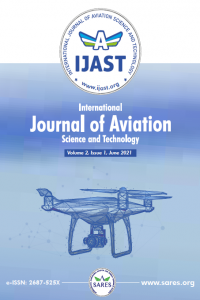Architecture of Stratosphere Rocket for CubeSats
Architecture of Stratosphere Rocket for CubeSats
Launch Vehicle, Rocket Cubesat, Design, Analysis, Stratosphere,
___
- [1]Balmogim, U., Brooks, M. J., Pitot de la Beaujardiere, J. F., Veale, K., Genevieve, B. and Roberts, L. W., 2015. Preliminary Design of the Phoenix-1B Hybrid Rocket. Orlando, 51st AIAA/SAE/ASEE Joint Propulsion Conference.
- [2]Barrowman, J.A., Theoretical Prediction of the Center of Pressure, Cambridge, 1966.
- [3]Bartz, D. R., 1957. A Simple Equation for Rapid Estimation of Rocket Nozzle Convective Heat Transfer Coefficients. Journal of Jet Propulsion, 27(1), pp. 49-53.
- [4]Bartz, D. R., 1965. Turbulent Boundary-Layer Heat Transfer from Rapidly Accelerating Flow of Rocket Combustion Gases and of Heated Air. Advances in Heat Transfer, Volume 2, pp. 1-108.
- [5]Besnard, E., Chen, H. H., Mueller, T., & Garvey, J. (2002, July). Design, manufacturing and test of a plug nozzle rocket engine. In 38th AIAA/ASME/SAE/ASEE Joint Propulsion Conference & Exhibit (p. 4038).
- [6]Brooks, M. J., Pitot de la Beaujardiere, J. F., Chowdhury, S. M., Genevieve, B. and Roberts, L. W., 2010. Introduction to the Univeristy of KwaZulu-Natal Hybrid Sounding Rocket Program. Nashville, American Institude of Aeronautics and Astronautics.
- [7]Bossert, D. E., Morris, S. L., Hallgren, W. F., & Yechout, T. R. (2003). Introduction to aircraft flight mechanics: Performance, static stability, dynamic stability, and classical feedback control. American Institute of Aeronautics and Astronautics.
- [8]Box, S., Bishop, C. Hunt, H., Estimating the dynamic and aerodynamic paramters of passively controlled high power rockets for flight simulaton, 2009.
- [9]Chowdhury, S. M., 2012. Design and Performance Simulation of a Hybrid Sounding Rocket,MScEng Thesis, Durban: University of KwaZulu-Natal.
- [10]Dyer, J., Doran, E., Dunn, Z., Lohner, K., Bayart, C., Sadhwani, A., Zilliac, G., Cantwel, B. and Karabeyoglu, A., 2007. Design and Development of a 100km Nitrous Oxide/Paraffin Hybrid Rocket Vehicle. Cincinnati, 43rd AIAA/ASME/SAE/ASEE Joint Propulsion Conference and Exhibit.
- [11]Genevieve, B., Pitot, J., Brooks, M., Chowdhury, S., Veale, K., Leverone, F., Balmogim. U. and Mawbey, R., 2015. Flight Test of the Phoenix-1A Hybrid Rocket. Orlando, 51st AIAA/SAE/ASEE Joint Propulsion Conference, AIAA Propulsion and Energy Forum.
- [12]Leverone, F. K., 2013. Performance Modelling and Simulation of a 100 km Hybrid Sounding Rocket, MScEng Thesis, Durban: University of KwaZulu-Natal.
- [13]Mahjub, A., Mazlan, N. M., Abdullah, M. Z., & Azam, Q. (2020). Design Optimization of Solid Rocket Propulsion: A Survey of Recent Advancements. Journal of Spacecraft and Rockets, 57(1), 3-11.
- [14]Mandell, G., Caporaso, G., Bengan, W.,Topcis in Advanced Model Rocketry, NARAM-8, 1978.
- [15]Maruyama, S. (2020). Concept design of linear-motor-accelerated projectile for nanoparticle dispersion in stratosphere. Thermal Science and Engineering Progress, 15, 100437.
- [16]McCormick, A., Hultgren, E., Lichtman, M., Smith, J., Sneed, R. and Azimi, S., 2005. Design, Optimization, and Launch of a 3" Diameter N2O/Aluminized Paraffin Rocket. Tucson, 41st AIAA/ASME/SAE/ASEE Joint Propulsion Conference & Exhibit.
- [17]Mishra, A. K., Gandhi, K., Sharma, K., Sumanth, N., & Teja, Y. K. (2021). Conceptual design and analysis of two stage sounding rocket. International Journal of Universal Science and Engineering, 7(1), 52-72.
- [18]Sutton, G. P., & Biblarz, O. (2016). Rocket propulsion elements. John Wiley & Sons.
- [19]Şanlı, A., Aslan, A.R. (2021). Design of ASTINSAT-1 And Structural Analysis, Use of Generative Design. International Congress On Engineering And Technology Management.
- [20]Taylor, T. S. (2017). Introduction to rocket science and engineering. CRC Press.
- [21]Johnstone, A. (2020). Cubesat Design Specification (1U-12U) Rev 14 CP-CDS-R14. The Cubesat Program, Cal Poly SLO, July.
- Yayın Aralığı: Yılda 2 Sayı
- Başlangıç: 2020
- Yayıncı: Sürdürülebilir Havacılık Araştırma Derneği
Electric aircraft battery performance: examining full discharge under two conditions
Denner CUNHA, Brooke WHEELER, Isaac SİLVER, Gaspar ANDRE
Maintenance 4.0: Automation of Aircraft Maintenance Operational Processes
Architecture of Stratosphere Rocket for CubeSats
Alper ŞANLI, Tuncay Yunus ERKEÇ, Melih BECEREN, Mehmet Furkan KEMALLI
Passive Isolator Design and Vibration Damping of EO/IR Gimbal Used in UAVs
Mehmet Taha GÖRMÜŞ, Bilal Faruk ADIN, Paşa YAYLA
The Detection Capability Of Laser Fuze In Fog, Mist, And Haze Using Monte Carlo Simulations
Nguyễn HOANG LİNH, Trung Dung PHAM, Hong Son TRAN, Chung NGUYEN
